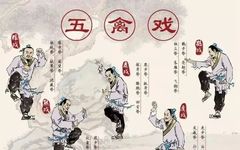Click the blue text above “Needle and Stone” and follow
Introduction
The Five Animal Frolics, created by the famous physician Hua Tuo during the late Eastern Han Dynasty, is a set of exercises based on TCM principles that mimic the movements and postures of five animals: the tiger, deer, bear, monkey, and bird. In 2011, the Five Animal Frolics was approved by the State Council and included in the third batch of national intangible cultural heritage. The movements are graceful, practiced in place, easy to learn, and are favored by many enthusiasts.
TCM guiding exercises embody the wisdom of ancient people. These exercises can improve qi and blood, enhance yang energy, and thus increase the body’s resistance to achieve the goal of health maintenance and disease prevention.
Today, we will introduce the TCM guiding exercise method of the Five Animal Frolics. Let’s practice together with family and friends!
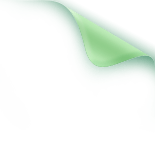
Historical Origins
Inheritors of Hua Tuo’s Five Animal Frolics believe that its origins can be traced back to ancient times. Historical records indicate that during that period, the Central Plains were flooded, and many people suffered from joint ailments. In this context, the ancients devised exercise methods such as “creating a dance” and “guiding it” to benefit health.This dance, aimed at mimicking the movements and postures of flying birds and running beasts, is also a budding form of ancient Chinese qigong guiding exercises.In the “Zhuangzi,” it is described: “Exhale the old and inhale the new, the bear stretches and the bird extends, for longevity.” The phrase “the bear stretches and the bird extends” refers to the ancient health practitioners imitating animal postures and practicing qigong.During the Eastern Han Dynasty, Hua Tuo inherited the guiding exercises of his predecessors and, based on his own TCM theoretical foundation, created a more complete version of the Five Animal Frolics, which is now known as “Hua Tuo’s Five Animal Frolics.”The earliest record of Hua Tuo’s creation of the Five Animal Frolics can be found in the “Records of the Three Kingdoms” by Chen Shou from the Western Jin: “I have a technique called the Five Animal Frolics, which includes the tiger, deer, bear, monkey, and bird. It is also used to eliminate diseases and benefit the feet, as a form of guiding exercise.” The records from Fan Ye during the Southern and Northern Dynasties in the “Book of the Later Han” are similar. These historical materials strongly prove that Hua Tuo indeed created the Five Animal Frolics.During the Wei, Jin, Southern and Northern Dynasties, the Five Animal Frolics developed significantly, with various specialized texts and illustrations of guiding exercises emerging, leading to a greater variety of names. In the Jin Dynasty, Ge Hong recorded in the “Baopuzi” various names such as “Dragon Guiding, Tiger Leading, Bear Stretching, Turtle Yawning, Bird Extending, and Monkey Perching.”During the Sui and Tang Dynasties, the Five Animal Frolics became even more popular. The Tang poet Liu Zongyuan wrote, “Hearing the way, I practice the Five Animal Frolics everywhere,” and the Song poet Lu You also wrote, “Pecking and swallowing, laughing like a solitary crane, guiding exercises are effective like the Five Animals,” and “Not moving like a bear lying down, slightly laboring to learn the bird’s extension.” It is evident that during the Sui, Tang, and Song Dynasties, the Five Animal Frolics spread widely due to its profound TCM principles and ancient health wisdom.During the Ming and Qing Dynasties, the Five Animal Frolics saw significant development, with research monographs continuously being published. Notable works include Zhou Lujing’s “Yimen Guangdu Chifeng Sui,” which meticulously illustrated the movements of the Five Animal Frolics and included them in the book. In the Qing Dynasty, Cao Ruoshui’s “Wanshou Xianshu Guiding Chapter” and Xi Xifan’s “Five Animal Dance Techniques” also detailed the practice methods of the Five Animal Frolics.These techniques differ significantly from those recorded in the “Nourishing Life and Longevity Record,” where the movements of the Five Animals are all single forms, and the order is changed to “Tiger, Bear, Deer, Monkey, Bird.” However, the textual descriptions not only detail the movements of the Five Animals but also include requirements for their postures, combined with the flow of qi and blood. These valuable literary materials provide important references for future research.
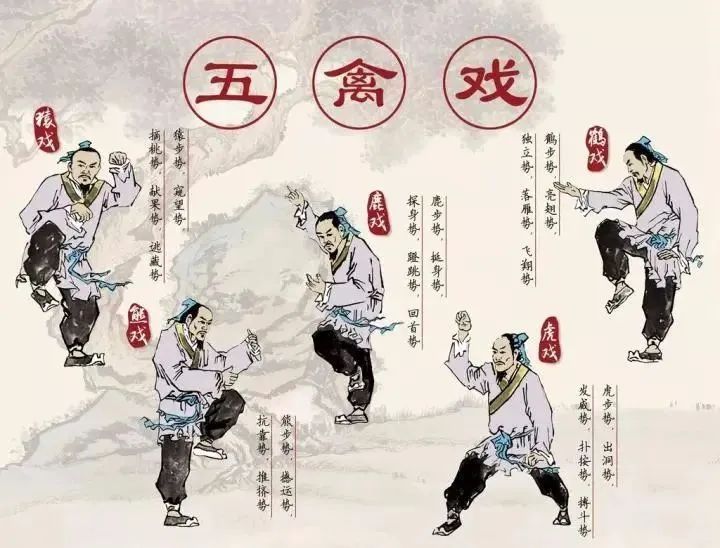

Preparatory Position
Assuming the preparatory position, step left with the left foot, shoulder-width apart, knees slightly bent, head straight, tongue against the palate, chest relaxed, back straight, waist and hips relaxed, shoulders dropped, elbows hanging, arms naturally hanging down, fingertips pointing down, palms facing each other, the whole body relaxed, with a slight smile, eyes focused forward, clearing the mind, concentrating on the lower dantian, and looking straight ahead. Relax the shoulders, slightly bend the elbows, raise both palms to eye level, palms facing up, fingertips pointing forward; look straight ahead. Relax the shoulders, drop the elbows, bring the palms together, palms facing down, fingertips facing each other, press down in front of the body, naturally dropping to the sides, fingertips pointing down, palms facing inward; look straight ahead.
First Frolic
Deer Frolic for Liver Regulation
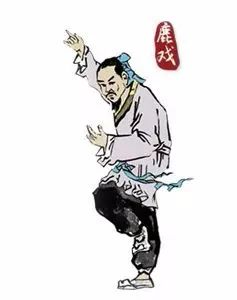
1. **Mei Lu Stretching Waist** (1) Assume the starting position, facing south; stand on the right leg, bend the left knee at 90 degrees, forming a right front bent knee independent stance; at the same time, shape both hands into deer antlers (middle and ring fingers curled inward, the other three fingers extended), externally rotate and raise them at the waist, palms facing up, tips of the antlers pointing forward; look straight ahead. (2) Step forward with the left foot, toes pointing up; at the same time, raise both antlers from the waist, rotating them upward to above the head, tips of the antlers pointing up, palms facing forward; look straight ahead. (3) The left leg extends outward to land, feet parallel, shoulder-width apart; at the same time, both arms arc outward and downward, bringing the antlers down to the sides, palms facing inward; look straight ahead. 2. **Neck Rotation and Tail Movement** (1) Facing south, shift the center of gravity to the left leg, turn to the right facing west, with the right toes pointed outward, stepping firmly, then shift the center of gravity to the right leg, stepping left with the left foot parallel to the right foot, with a distance greater than shoulder width, relaxing the waist and bending the knees into a half-squat, forming a horse stance; at the same time, raise both antlers to the left front above shoulder level, tips of the antlers pointing up, palms facing outward; look at the antlers. (2) Centering on the tailbone, draw both antlers in a circular motion to the right, down, and left for three rounds, with the tips of the antlers pointing to the edge of the circle; look at the antlers, moving the head and neck in sync, shifting the center of gravity accordingly. 3. **Deer Antlers Display** (1) Facing east, retract the right leg, bending the knee to touch the ground, forming a right ding step, while the left leg sits with the hip bent, shifting the center of gravity to the left leg; at the same time, arc both antlers outward and backward, rotating them inward to the waist, tips of the antlers pointing forward, palms facing up; look straight ahead. (2) Step right with the right foot into a large step, bending the right knee into a bow stance, shifting the center of gravity to the right leg, while the left leg extends, toes pointing inward; at the same time, rotate the antlers from the waist outward, extending the right arm to the right, wrist relaxed, tips of the antlers pointing up, palms facing right; the left antler raises to the right above shoulder level, tips of the antlers pointing right, palms facing outward; look straight ahead. (3) Retract the right foot, turn to face south, standing with feet parallel, shoulder-width apart; at the same time, arc both arms outward and backward, retracting to the sides, fingertips pointing down, palms facing inward; look straight ahead.Effects of the Deer Frolic: The Deer Frolic primarily stretches the lateral muscles, focusing on the liver and tendons, massaging the liver and gallbladder, unblocking the liver and gallbladder meridians, and strengthening the liver and tendons. It helps prevent and treat dizziness, chest and abdominal distension, emotional discomfort, and menstrual irregularities caused by liver stagnation.
Second Frolic
Monkey Frolic for Heart Nourishment
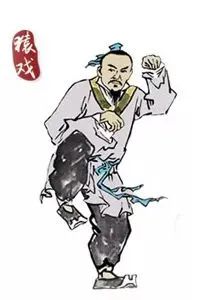
1. **White Monkey Climbing Branches**: Facing south, jump with the left foot, landing on the front palm, then stabilize independently, bending the right knee at 90 degrees, forming a left front bent knee independent stance; at the same time, the left hand reaches up, fingers slightly bent, palm facing forward, resembling climbing a branch; the right hand bends at the wrist to form a monkey hook (fingers pinched together, wrist bent to form a hook) and is drawn to the waist; look at the left hand. 2. **White Monkey Picking Fruit**: Facing south, the left leg sinks with the hip bent, leaning forward, while the right leg lifts backward and upward, toes pointing up, forming a left independent balance stance; at the same time, extend the left arm forward, fingers slightly bent, palm facing down, resembling grasping fruit, then “grip firmly” (the other four fingers hold the thumb); the right arm bends at the elbow, forming a monkey hook and is drawn to the waist; look at the left hand. 3. **White Monkey Scratching**: (1) Facing south, retract the left foot to stand parallel with the right foot, shoulder-width apart, while the right leg steps back to the left, forming a left high resting stance; at the same time, the left hand arcs from above the head to the abdomen, while the right hand arcs from the abdomen to above the head, crossing in front of the chest with the left hand inside, palms facing inward; look straight ahead. (2) Squat down into a left low resting stance; at the same time, the left hand drops to the left waist, and the right hand arcs to the right side of the head, both shoulders shrugging, with both arms making small elbow and wrist movements, resembling scratching three times; turn the head and neck to the left; look at the left upper side. (3) Without moving the lower body, switch hands, raising the left hand to the left side of the head, while the right hand drops to the waist, both shoulders shrugging, and each hand scratches three times; turn the head and neck to the right; look at the right upper side. (4) Move both hands to the front of the chest, shrugging both shoulders, and each hand scratches three times; look at both hands.Effects of the Monkey Frolic: The Monkey Frolic involves movements of peering, looking, grasping, jumping, and dodging, emphasizing agility and speed, focusing on the heart and pulse, massaging the heart, unblocking the heart and small intestine meridians, and nourishing the heart and brain. It helps prevent and treat irregular blood circulation and heart issues such as palpitations, heart pain, insomnia, vivid dreams, forgetfulness, and fatigue.
Third Frolic
Bear Frolic for Spleen Strengthening
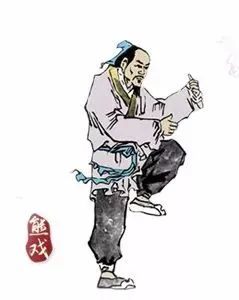
1. **Black Bear Probing Claws**: (1) Facing south, bend the right leg at the hip, while the left leg bends with the toes touching the ground, forming a left ding step; at the same time, bend both arms at the elbows, forming bear paws (fingers spread, bent like dull hooks, thumb close to the index finger), raised to the right side of the body, level with the navel, palms facing down; look at the paws. (2) Both bear paws arc from the right side to the left front, turning the body to face southeast, stepping left with the left foot, with the right foot following, forming a left chicken stance; look at the paws. (3) Bend the elbows, pulling both bear paws back through the abdomen to the right side, making a flat circle; keep the feet in the left chicken stance, shifting the center of gravity to the right leg; look at the paws. 2. **Clumsy Bear Walking**: Facing southeast, retract the right foot, turn to face south, standing on the right leg, while the left leg lifts the hip, bending the knee and raising the heel, landing on the toes, walking slowly in place; at the same time, the right bear paw reaches forward, while the left bear paw wraps around the back, both paws level with the navel, palms facing down; look at the left paw, turning the neck to follow. 3. **Clumsy Bear Shaking Body**: (1) Facing south, with feet parallel; turn to face southeast, stepping left with the left foot into a left chicken stance; at the same time, lean forward, using the shoulder to lead the arm, extending the left arm downward and forward, palm facing right; the right arm retracts upward and backward, palm facing left; the left knee slightly bends, the right leg straightens, shifting the center of gravity to the left leg; look straight ahead. (2) Using the shoulder to lead the arm, retract the left arm upward and backward, palm facing right; extend the right arm downward and forward, palm facing left; at the same time, straighten the left leg, slightly bend the right knee, shifting the center of gravity to the right leg; look straight ahead.Effects of the Bear Frolic: The Bear Frolic stimulates the abdominal organs, focusing on the spleen and stomach, massaging the gastrointestinal tract, unblocking the spleen and stomach meridians, and strengthening the spleen and stomach. It helps prevent and treat issues such as poor appetite, belching, hiccups, abdominal distension, diarrhea, and constipation caused by spleen and stomach disharmony.
Fourth Frolic
Bird Frolic for Lung Nourishment
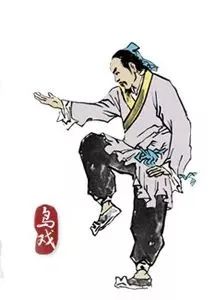
1. **White Crane Flying**: (1) Assuming the previous position, facing south; stand on the right leg, lift the left leg at the hip, bending the knee at 90 degrees, with the heel down and toes pointing down, forming a right front bent knee independent stance; at the same time, using the shoulder to lead the arms, extend both arms to the sides, slightly above shoulder level, shaping the hands like bird wings (fingers extended, middle and ring fingers together pointing down, the other three fingers raised), palms facing down; look straight ahead.
(2) Bend the right leg at the hip, lowering the center of gravity, while the left leg bends with the toes touching the ground, forming a right side bent knee independent stance; at the same time, using the shoulder to lead the arms, let both arms drop to the sides, returning the hand shape to palms facing each other; look straight ahead.
2. **Group Cranes Landing**: (1) Facing southwest; turn to face south, retract the right foot, standing with feet parallel, bending the left leg and raising the heel with toes pointing down; at the same time, both hands arc from the abdomen to above the head, shaping the hands like bird wings, with the left hand inside, palms facing outward; look straight ahead.
(2) Land the left foot, parallel to the right foot, with a distance greater than shoulder width; at the same time, both arms arc upward and backward, palms rotating outward, palms facing up; lean the head and body back, looking up.
(3) Both arms arc forward and downward, returning the hand shape to palms facing down, fingertips pointing toward the ground, as if touching the ground; lean the head and body forward, looking down.
3. **White Crane Diving**: (1) Facing south, standing, keeping the lower body movements unchanged; raise the right arm from the front lower side, arcing to the left and upward, then to the right, fingertips pointing up, palm facing forward; the left arm raises to the side; look at the right hand.
(2) The left arm arcs from the side upward over the head, diving down to the outside of the right foot, palm facing down, fingertips pointing down; at the same time, lean the head and body forward, keeping the right arm raised, palm facing backward; look at the right foot.
4. **Flying Crane Spreading Wings**: (1) Facing south, turn to face southeast, stepping forward with the left foot into a left chicken stance; at the same time, both arms arc forward to meet, fingertips pointing forward, palms facing each other, shifting the center of gravity forward; look straight ahead.
(2) Using the shoulder to lead the arms, both arms arc backward horizontally, shaping the hands like bird wings; at the same time, straighten the left leg, with the heel on the ground and toes raised, while the right leg bends at the hip, forming a right sitting stance; look straight ahead.
(3) Using the shoulder to lead the arms, both arms arc forward to retract, returning the hand shape to palms facing each other, fingertips pointing forward; the left foot fully on the ground, the right foot heel raised, shifting the center of gravity forward; look straight ahead.
5. **Group Cranes Cleansing**: (1) Facing south; turn to face southeast, stepping forward with the left foot into a left chicken stance; lean forward, extending the left arm downward and forward, palm facing down, fingertips pointing forward; the right arm raises to the side, palm facing backward; at the same time, slightly bend the left knee, raising the right heel, shifting the center of gravity forward; look at the left hand.
(2) Straighten up, extending the left knee, raising the left toes, while the right leg bends at the hip, shifting the center of gravity backward; at the same time, using the shoulder to lead the arms, raise the left arm backward, palm facing down, making a circular motion; let the right arm drop, palm facing down, fingertips pointing forward; look at the left hand.
6. **Landing on Rocks**: (1) Facing south; stand on the right leg, bending the left knee with toes pointing down; at the same time, both hands arc from the abdomen to above the head, shaping the hands like bird wings, with the left hand inside, palms facing outward; look straight ahead.
(2) Land the left foot, parallel to the right foot, shoulder-width apart; squat down, bending the knees, while using the shoulder to lead the arms, both arms arc outward and downward, returning the hand shape to palms facing each other, fingertips pointing down; look straight ahead.
(3) Contract the abdomen, lift the anus, and gradually stand upright; at the same time, using the shoulder to lead the arms, both arms arc upward to above the head, shaping the hands like bird wings, fingertips pointing up, backs of the hands facing each other; look straight ahead.
(4) Relax the abdomen, relax the anus, lower the heels, standing with feet parallel; at the same time, using the shoulder to lead the arms, both arms arc outward and downward, returning the hand shape to palms facing each other, fingertips pointing down; look straight ahead.
Effects of the Bird Frolic: The Bird Frolic exercises the chest and arms, focusing on the lungs and skin, expanding and contracting the chest, massaging the lungs, unblocking the lung and large intestine meridians, and nourishing the lungs and strengthening the exterior. It helps prevent and treat lung qi deficiency and issues caused by improper qi descent, such as shortness of breath, cough, fatigue, susceptibility to colds, and organ prolapse.
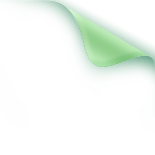
Fifth Frolic
Tiger Frolic for Kidney Strengthening
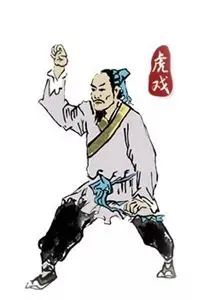
1. **Fierce Tiger Seeking Food**
(1) Facing south, step forward with the left foot into a left chicken stance; at the same time, shape both hands into tiger claws (fingers spread, tiger mouth rounded, finger joints bent inward forming dull hooks), with the left claw arcing from above the head to the side, palm facing down; the right claw arcs from the abdomen upward, palm facing up, crossing in front of the chest with the left claw inside; look at the claws.
(2) Bend the left knee into a front bow stance; at the same time, bend both arms, pressing the left claw downward, palm facing down, while the right claw pushes upward, palm facing forward; turn the head and neck to the left, looking at the right foot.
2. **Shaking Head and Tail**: Facing south, retract the right foot, standing with feet parallel, stepping left into a left empty step; lean forward, extending the arms, palms facing down, using the waist as a pivot, making three circular motions with both claws from left to right; turn the head and neck to follow the claws, looking at them.
3. **Rolling and Pressing Down**: (1) Facing south, shift the center of gravity back to the left leg, slightly turning the upper body to the left, with the right toes pointed inward, stepping firmly, then shift the center of gravity to the right leg; at the same time, extend both arms forward, palms facing down, raising the claws from the front, arching over the head, pivoting at the waist, turning to the left and rolling over, facing north, looking at the claws.
(2) Facing north, bend the right leg at the hip, stepping into a left empty step; at the same time, both arms drop vertically to the sides; look straight ahead.
(3) Lift the left leg at the hip, standing on the right leg; at the same time, raise both claws to eye level, palms facing forward; look at both claws.
(4) Step down with the left foot, bending the knee into a left front bow stance; at the same time, press both claws downward to the sides, palms facing down; look straight ahead.
Effects of the Tiger Frolic: The Tiger Frolic exercises the waist, spine, and joints, focusing on the kidneys and bones, massaging the kidneys, unblocking the kidney and bladder meridians, and strengthening the kidneys and bones. It helps prevent and treat kidney essence deficiency leading to lower back and knee weakness and pain, tinnitus, impotence, low sperm count, and menstrual irregularities.

Closing Position
Guiding Qi Back to the Source
Assuming the closing position, retract the right foot, standing with feet parallel as in the starting position. Raise both palms upward to above the head, then bring them together in front of the body and press down. Raise the arms, contract the abdomen while inhaling, press down and relax the abdomen while exhaling, completing a full cycle, referring to the Bird Frolic’s Landing on Rocks position. Raise both palms from the chin to the forehead and cheeks repeatedly six times. Massage from the forehead down the neck, chest, abdomen, and lower limbs from front to back to the buttocks. Strike the Mingmen point nine times. Tap the dantian nine times. Return to the preparatory position.

Precautions
“Breathing in the three islands at sea, practicing the Five Animals in the temple.”The Five Animal Frolics has been a popular health maintenance method since the Eastern Han Dynasty, with specific applications including both preventive measures for the healthy and therapeutic measures for the sick.For fitness and preventive health, the complete set of exercises can be practiced continuously, generally 2-3 times per session, with movements flowing smoothly like clouds and water, concluding with the closing position of guiding qi back to the source, practiced once or twice daily.For treating diseases and preventing changes, the main principle is to differentiate diseases and apply the appropriate frolics based on the affected organs.Hua Tuo believed: “The Five Animal Frolics should be practiced according to one’s strength, with sweating as the measure.”During practice, the whole body should be relaxed, movements natural, and emotions optimistic. Each frolic has its unique characteristics, such as the bear’s heaviness, the monkey’s agility, the tiger’s strength, the deer’s gentleness, and the crane’s liveliness. When practicing, one should adapt to the characteristics of each movement, ensuring that the actions are natural and expansive, and not overly rigid, focusing the mind on the designated areas while clearing distractions and concentrating.Compiled from “Chinese Medicine,” “TCM Publishing,” “Capital TCM,” “Shanxi Medical University Second Hospital Student Association”Copyright belongs to the original author.************The content of the article represents the author’s academic views and does not reflect the platform’s position; the content of the article (including ideas, prescriptions, and practical operations) is for reference only. Please ensure to use under the guidance of a professional physician; do not blindly try the prescriptions and operations mentioned, as this platform does not bear any responsibility for any consequences arising from this.Some images in the article are sourced from the internet for public dissemination. We thank the original authors of the images. If there is any infringement, please contact us for removal.
Setting this account as a “star” will make it easier to see the latest articles (enter this account, click the upper right corner “…”, go to the history page, click the upper right corner again, and select “set as star”); if you find this article valuable, please click “see more” to share it with more people.

